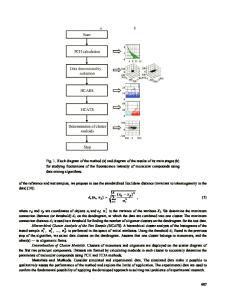Effect of GeO 2 additive on fluorescence intensity enhancement in bismuth-doped silica glass
- PDF / 804,970 Bytes
- 4 Pages / 585 x 783 pts Page_size
- 31 Downloads / 266 Views
Yuki Hirata Kinki University, School of Science and Engineering, Department of Electric and Electronic Engineering, Higashi-Osaka 577-8502, Japan
Yoshiyuki Kuwada, Takahiro Sato, and Masahiro Nakatsuka Institute of Laser Engineering, Osaka University, Suita, Osaka 565-0871, Japan (Received 27 September 2006; accepted 12 December 2006)
We observed the enhancement of fluorescence intensity due to the addition of GeO2 in bismuth-doped silica glass (BiSG), which has a peculiar fluorescence at 1.25 m with a full width at half-maximum of 300 nm. Experimental results revealed that the fluorescence intensity from BiSG with 5.0 mol% GeO2 increased remarkably to be 26.3 times greater than that without GeO2 additive for the same Bi2O3 concentration (0.1 mol%). Furthermore, the enhanced sample showed almost the same intensity as BiSG without GeO2 for 1.0 mol% Bi2O3. These results demonstrate that GeO2 additive effectively promotes the generation of peculiar luminescent centers.
Infrared fluorescence materials such as Nd:yttrium aluminum garnet (YAG) and Er-doped silica fiber are widely used as laser media. There are many advantages to the presence of fluorescence in the infrared region because there are many types of optics; we can use semiconductor lasers or flash lamps for their excitation, and it is also possible to obtain a frequency-doubled beam with a nonlinear crystal in the visible light region. Therefore, such light sources are broadly applicable for scientific research and industrial use. Fujimoto et al. discovered a new infrared fluorescence from a bismuth-doped silica glass (BiSG).1 This broad fluorescence exists between 1000 and 1600 nm, and the absorption is in the visible light region. Its lifetime is 630 s at room temperature. Because this silica glassbased material has fluorescence around 1.3 m of zerodispersion wavelength, it can be used as a core material for an optical fiber amplifier for telecommunications in the 1.3-m range. Fujimoto et al. also demonstrated optical amplification at 1.3 m with 0.8-m excitation.2 Recently, Psaila et al. successfully fabricated highquality embedded channel waveguides inside Bi-doped silicate glass using femtosecond waveguide inscription.3 Therefore, BiSG shows promise as a substitute for a
a)
Address all correspondence to this author. e-mail: [email protected] DOI: 10.1557/JMR.2007.0073 J. Mater. Res., Vol. 22, No. 3, Mar 2007
http://journals.cambridge.org
Downloaded: 17 Mar 2015
Pr3+:ZrF4-BaF2-LaF3-AlF3-NaF (ZBLAN) fiber amplifier or a Raman amplifier in the 1.3-m region. While it has been recognized that the spectroscopic properties of BiSG are different from those of previously reported Bi luminescent material with a Bi3+ luminescent center,4–6 the fluorescence mechanism remains unclear. The local structure of Bi luminescent centers in BiSG has been analyzed because these data, such as the valence state and the coordination state of Bi ions, are expected to exhibit important information on the energy-level diagram. The valence state of the Bi ion
Data Loading...











